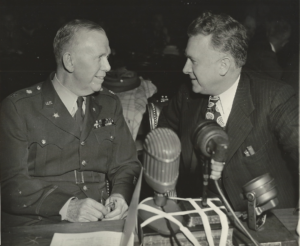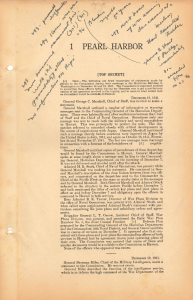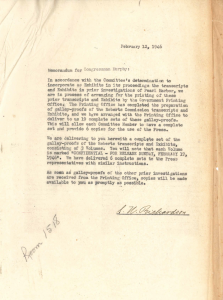 On January 28, 1942, the Roberts Commission, which had been appointed by President Roosevelt to investigate and report the facts relating to the Japanese attack at Pearl Harbor, presented its findings to Congress. Throughout its month-long investigation, the commission interviewed 127 witnesses including Army Chief of Staff George C. Marshall who testified before the commission on January 19th.
On January 28, 1942, the Roberts Commission, which had been appointed by President Roosevelt to investigate and report the facts relating to the Japanese attack at Pearl Harbor, presented its findings to Congress. Throughout its month-long investigation, the commission interviewed 127 witnesses including Army Chief of Staff George C. Marshall who testified before the commission on January 19th.
During his brief testimony, the commission asked Marshall about the difficulties in transmitting a warning message to General Short, the Commander of the Hawaiian Department, on the morning of December 7th, the reconnaissance operations that General Short had received orders to undertake, the communication between General Short and Admiral Kimmel regarding defense preparations for Hawaii, whether Marshall was surprised that Pearl Harbor was attacked.
 The final report of Roberts Commission concluded that a lack of communication between General Short and Admiral Kimmel regarding the warning of possible hostilities against Pearl Harbor, the absence of frequent and coordinated reconnaissance, the overemphasis on the defense of military installations against sabotage only, and the prevailing conviction among commanding officers that the Japanese had no intention or attacking Pearl Harbor left the army and navy less prepared than they could have been for the attack. The commission noted that Marshall had performed his duties of communicating with Admiral King about Hawaiian defense and issuing warning and orders to General Short satisfactorily and that his order to General Short to perform reconnaissance and any other necessary preparations as a defense against Japanese hostile actions clearly conveyed General Short’s responsibilities.
The final report of Roberts Commission concluded that a lack of communication between General Short and Admiral Kimmel regarding the warning of possible hostilities against Pearl Harbor, the absence of frequent and coordinated reconnaissance, the overemphasis on the defense of military installations against sabotage only, and the prevailing conviction among commanding officers that the Japanese had no intention or attacking Pearl Harbor left the army and navy less prepared than they could have been for the attack. The commission noted that Marshall had performed his duties of communicating with Admiral King about Hawaiian defense and issuing warning and orders to General Short satisfactorily and that his order to General Short to perform reconnaissance and any other necessary preparations as a defense against Japanese hostile actions clearly conveyed General Short’s responsibilities.
Since the Roberts Commission’s investigation began shortly after the attack on Pearl Harbor and was conducted during war time, its primary purpose was to gather all of the facts relating to the incident. After World War II was over, other more in-depth investigations into the attack on Pearl Harbor were undertaken. Not surprisingly George C. Marshall was again called to testify. Marshall appeared before the Joint Committee on the Investigation of the Pearl Harbor Attack from December 6-13, 1945, and over these days he testified for a total of 26 hours and 10 minutes.
 Marshall’s testimony before the Roberts Commission and other hearing boards and commissions can be found in the John W. Murphy Collection that was recently acquired by the Marshall Foundation archives. The Honorable John W. Murphy was serving as the representative from Pennsylvania’s 11th congressional district when he was appointed to Joint Committee.
Marshall’s testimony before the Roberts Commission and other hearing boards and commissions can be found in the John W. Murphy Collection that was recently acquired by the Marshall Foundation archives. The Honorable John W. Murphy was serving as the representative from Pennsylvania’s 11th congressional district when he was appointed to Joint Committee.
As a member of the Joint Committee Murphy received a complete 14-volume set of the galley proofs of the Hearings Before the Joint Committee on the Investigation of the Pearl Harbor Attack published by the U.S. Government Printing Office in February 1946. In a memorandum from Seth W. Richardson, General Counsel for the Joint Committee, Richardson explained that the set of galley proofs provided to Murphy was one of only 19 that were printed. One set was given to each member of the committee and 6 of the sets were made for the use by the press. The research library staff undertook an extensive search to determine if other sets of the galley proofs could be found among the papers of other members of the Joint Committee. As the research library staff was unable to identify a set of the galley proofs as part of the collections of any other archives, it is believed that the John W. Murphy Collection may contain the only surviving set of the original 19 sets of galley proofs that were produced.
